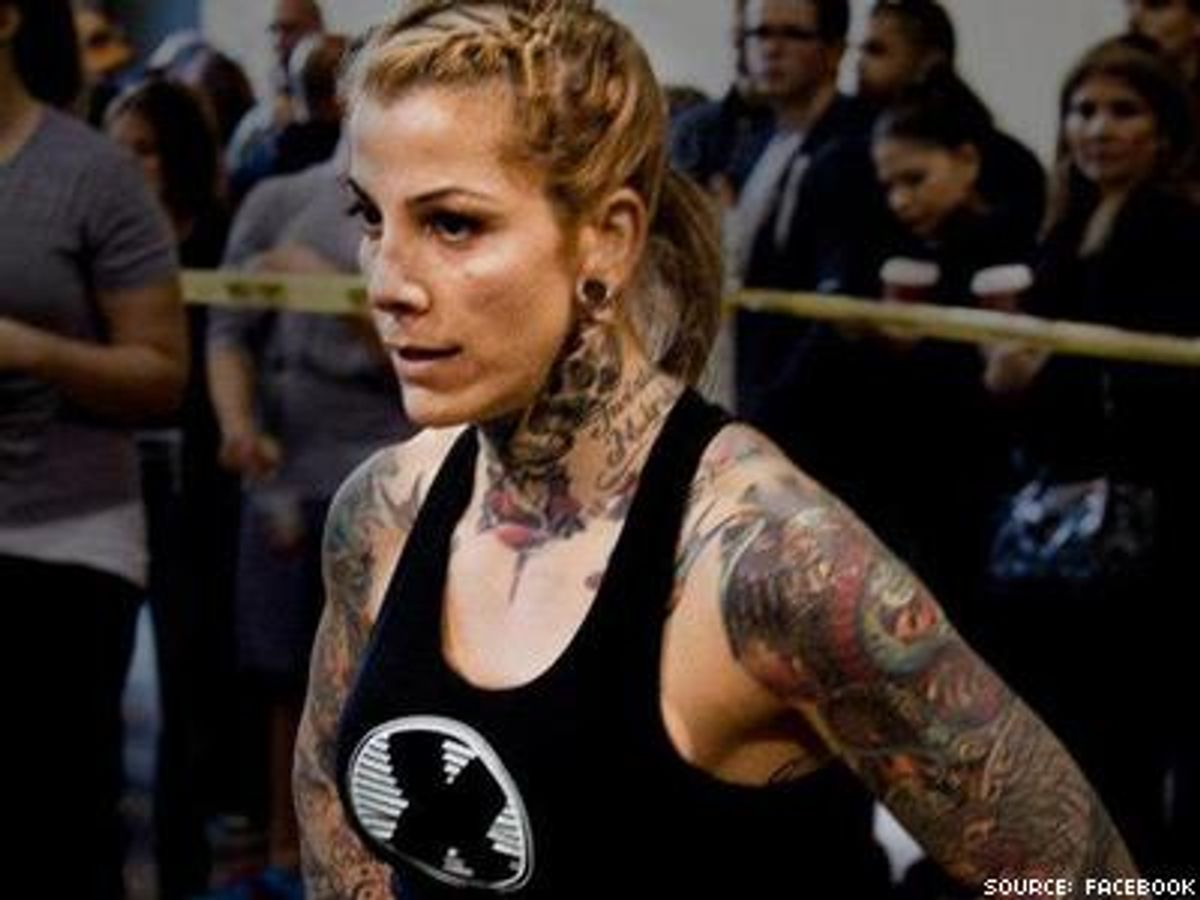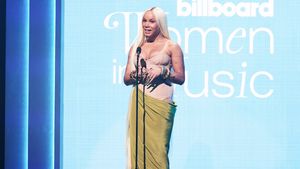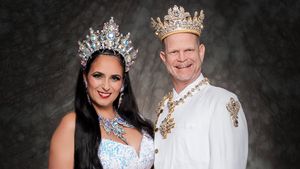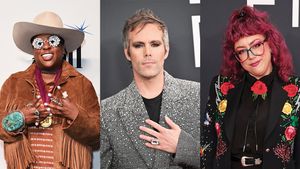A transgender woman is suing CrossFit after being denied entry in the fitness program's women's division.
Chloie Jonsson, 34, who transitioned more than eight years ago, is legally recognized as female in the state of California. Despite the medical community's consensus that transgender women do not have a competitive advantage over cisgender (nontrans) women, Jonsson's application to participate in CrossFit's women's division was rejected with a bizarre letter claiming she and her supporters do not understand "the human genome" and "fundamental biology." In response, Jonsson filed suit against the fitness giant.
The letter from CrossFit general counsel Dale Saran reads:
"We have simply ruled that based upon [Chloie] being born as a male, she will need to compete in the Men's Division. The fundamental, ineluctable fact is that a male competitor who has a sex reassignment procedure still has a genetic makeup that confers a physical and physiological advantage over women. ... Our decision has nothing to do with 'ignorance' or being bigots -- it has to do with a very real understanding of the human genome, of fundamental biology, that you are either intentionally ignoring or missed in high school."
Later, Saran disputes the statement made by Jonsson's attorney that "by all accounts, both physically and legally, Chloie Jonsson is a female."
"This is simply wrong as a matter of human biology and if you can't see that, there really isn't much to talk about," writes Saran, citing Encyclopedia Britannica. "Chloie was born, genetically -- as a matter of fact -- with an X and a Y chromosome and all of the anatomy of the human race. Today, notwithstanding any hormone therapy or surgeries, Chloie still has an X and a Y chromosome."
That final statement would imply that CrossFit has verified through a karyotype test that Jonsson has a Y chromosome, and also that the other competitors do not have a Y chromosome. Aside from being prohibitvely expensive to conduct such tests, human genetic diversity would indicate that it's fairly unlikely that no other female athletes competing in the CrossFit Games might possess a Y chromosome.
The International Olympic Committee abandoned the practice of using chromosomes to verify gender and eligibility more than 15 years ago. In the 1996 Summer Olympic Games, the IOC tested 3,387 female athletes. Of those, eight tested positive for a Y chromosome, to the surprise of both officials and the women themselves. Because intersex conditions and women with Androgen Insensitivity Syndrome are more common than one would ordinarily presume, the IOC ultimately determined that gender verification would not consist of a karyotype test, and instead would be a measure of testosterone levels.
Experts in the fields of biology and genetics also tend to disagree with CrossFit's statement. Eric Vilain, Director of the Center for Gender-Based Biology and Chief Medical Genetics Department of Pediatrics at UCLA, says of any perceived advantage a transgender woman may have, "Research suggests that androgen deprivation and cross-sex hormone treatment in male-to-female transsexuals reduces muscle mass; accordingly, one year of hormone therapy is an appropriate transitional time before a male-to-female student athlete competes on a women's team."
There is no evidence that transgender women who have been on hormone replacement therapy for a significant amount of time would have any physical, athletic advantage over their cisgender counterparts. As time carries on, transgender women are likely to lose a significant amount of pre-transition muscle mass, as a lack of testosterone makes the maintenance of muscles much more difficult. Additionally, after at least a year on hormone therapy, a trans woman's bone density and soft tissue makeup will also mirror that of a cisgender woman.
Jonsson, who is 5 feet, 4 inches tall, joins Fallon Fox, Kye Allums, Bobbi Lancaster, and other transgender athletes who have all had to fight for their right to compete, or navigate bureaucracy instilled by individuals and organizations with little-to-no understanding of transgender issues.
In an interview with the website Bloody Elbow, Dr. Sherman Leis, a world renowned surgeon, professor, lecturer and founder of the Philadelphia Center for Transgender Surgery, elaborated on the process and impact hormone replacement therapy has on transgender women.
"If an individual is on female hormones, and she's been on them for several years, the hormones decrease the muscle mass, bone density, strength, libido and aggression, Leis told Bloody Elbow. "Those things are attributed to testosterone, and if she no longer produces testosterone, then she would have the level that an average female would have." Referencing transgender MMA fighter Fallon Fox, Dr. Leis said, "She's been doing [hormone therapy] for so many years, that she probably does not have a significant advantage, if any at all," later stating that a transgender woman who has undergone the medical treatments both Fox and Jonsson have, "more than likely has the muscle mass, bone density and strength of most females."
In reality, transgender women may very well be at a disadvantage when competing against cisgender women. In a transgender woman who has undergone hormone replacement therapy and gender confirming surgery -- as Jonsson has -- testosterone levels generally register below the range of cisgender women. This happens as a result of trans women no longer generating testosterone from their testes, while cisgender women continue to produce testosterone in their ovaries. Testosterone drives muscle development and increases bone density. Chromosomes and genitals become irrelevant, as any physical advantage stems from testosterone levels.
From a size point of view, many top CrossFit athletes are actually significantly larger than Jonsson. Samantha Briggs, the 2013 winner of the CrossFit Games women's division, is nearly two inches taller than Jonsson, with several top competitors outweighing Jonsson, as well.
CrossFit's decision to ban transgender athletes from competing with their target gender demonstrates willful ignorance of biology that goes against nearly every policy in place for athletic competition, backed by data demonstrating that trans athletes don't have an advantage. Both the International Olympic Committee and the NCAA have policies in place that allow transgender athletes to compete. The IOC's policy requires athletes to undergo genital surgery, while the NCAA only stipulates that an athlete has undergone at least one year of hormone replacement therapy.
By CrossFit's own logic, a transgender man, with testosterone levels mirroring that of cisgender males and a similar pattern of muscle development, could choose to compete in the women's division -- which would actually afford the competitor an unfair advantage. Such a policy seems to encourage abuse, rather than prevent it. Additionally, it's ironic to see CrossFit, an organization built on the idea of encouraging people to improve their physical shape, so severely lacking the most basic understanding of what factors go into muscle development.
CrossFit's decision may also be in violation of California state law that bans discrimination on the basis of gender identity. As Jonsson's legal documents all recognize her as female, it doesn't appear that the fitness organization has a legal basis to bar her from competing in the women's division.
In 1977, a similar case was brought against the United States Tennis Association by Renee Richards. Richards, a transgender woman, sued the USTA for the right to compete in the U.S. Open. The landmark ruling in her favor was a major step forward for transgender athletes. At the conclusion of her playing career, Richards went on to coach tennis legend Martina Navratilova.

















































































